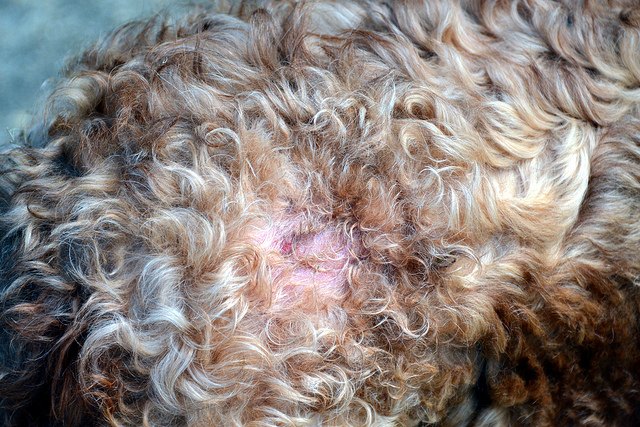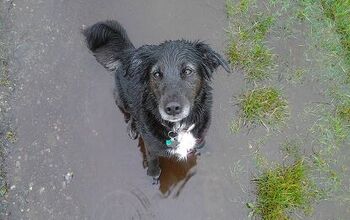What Are Hot Spots on Dogs?

Dogs can develop skin problems just as easily as humans but they can be more difficult to diagnose and treat since your dog’s body is covered with fur. One of the most commonly seen skin problems known to affect dogs is called a “hot spot.” Let’s talk about the basics of hot spots on dogs, what causes them, and how to treat them.
Identifying Hot Spots on Your Dog
The name “hot spot” actually refers to a condition called acute moist dermatitis and it is given to the red, hot, irritated lesions that sometimes form on a dog’s skin. Hot spots are most likely to develop on a dog’s head, chest, or hips and they can grow in size rapidly. A hot spot can be caused by anything that irritates your dog’s skin, causing him to scratch or lick himself. Common causes of hot spots include mites, flea bites, poor grooming, allergic reactions, and underlying skin infections or ear infections – they can also be brought on by excess chewing or licking caused by boredom. The more your dog licks, scratches, and chews the area, the larger and more painful the hot spot becomes.
Related: What Are The Most Common Dog Food Allergies?
Hot spots can affect dogs of any size, age, and breed. Your dog may be at a greater risk for developing hot spots, however, if he is not properly groomed. Dogs with oily, dirty, and matted coats are more likely to lick and chew themselves which creates hot spots. Canines that are frequently wet due to rain or swimming also have a higher risk. Dogs with thick, long coats are most frequently affected by hot spots. Although hip dysplasia is not a cause of hot spots, pain in the dog’s hips and hindquarters can lead the dog to lick or chew the area which might start a hot spot.
And though we said that any dogs of any breed can get hot spots, there are a few who are more prone to getting them. St. Bernards, Golden Retrievers, German Shepherds, Rottweilers and Labradors are predisposed because they have thicker coats of longer hair. Especially if you live in an area where there is a lot of warmer weather or humidity. That’s because those are prime opportunities for yeast infections to happen and that means itchy skin and paws your dog will chew until they become infected. That’s when you’ll need to look into treatment.
Treatment Options for Hot Spots
Because hot spots can grow quickly and become painful it is important that you get your dog the treatment he needs as soon as possible.
As we continue to learn more about our dog’s microbiome, we’ve found that bacteria, yeast and fungus (the ‘gut’ or ‘microbiome’ of your dog) play more into their overall health picture than we may have ever initially thought. As research shows the same for us humans, it makes sense that looking at our dogs’ microbiome when it comes to hot spots is a great start.
When a dog’s body system is out of balance, it’s considered dysbiosis. Basically, dysbiosis can happen anywhere–from the brain to the skin to the liver to the coat and hair of your dog. In humans, it can affect our mental health as well.
Continued research into helping body microbiome be healthy and prolific has pointed again and again to the use of pre- and probiotics. And when it comes to hot spots in dogs, attacking them from the inside out is a way to go.
You can start with ensuring their internal gut health is at its best. Giving dogs a hiqh-quality pre- and probiotic combination that will ensure maximum nutrient absorption means that every cell in your dog’s body will be fueled as it should be. This results in a healthier, shinier coat but also a healthier immune system that fights the irritation and infection that can create the hot spots in the first place.
Additionally, though, there’s merit in topical probiotics as well. Using a high-quality topical probiotic can help bring irritation under control and ensure that their skin microbiome (which can go into dysbiosis easily just from their roll-in-the-grass lifestyle) is its healthiest too. This double-attack on the ickies that can bring hot spots to your dog is the very best preventative and first line of treatment.
But if the hot spots should NOT get better, an increase in scratching, licking, or biting is also an indication of a problem that may require veterinary attention, and pretty quickly.
Related: What Are The Benefits Of Coconut Oil For Dogs?
When you bring your dog to the vet he will perform an exam in order to identify the underlying cause of the hot spots. Treatment options vary depending on the severity of the hot spot as well as the cause. In cases of extreme irritation, your vet may shave the hair surrounding the hot spot so he can apply a topical medication; this will also help make sure the wound is properly aerated to facilitate healing. Your vet may also prescribe antibiotics, painkillers, or anti-parasitics depending on the cause and severity of the hot spots. In some cases, your dog might also need to wear an e-collar to prevent him from further aggravating the area.
Hot spots are treatable but they can be irritating and painful for your dog so you should do what you can to prevent them from forming in the first place. Make sure your dog is properly groomed, especially if he has a long or thick coat. Going too long between grooming sessions can cause mats to develop which encourages your dog to lick and chew at his coat. Ask your veterinarian about flea and tick preventives and try to keep your dog’s coat as clean as possible. If you live in a warmer or more humid area, or your pup gets into lots of water activity, be sure that you dry those paws and ears really well so there aren’t yeast infections that pop up and lead to hot spots.
Although hot spots can be treated, allowing them to develop in the first place will cause your dog unnecessary pain and discomfort. By keeping your dog clean and properly groomed you can help prevent hot spots from forming. But additionally, making sure your dog’s gut and skin microbiome are flourishing with healthy probiotics and flora can do wonders, even for the most hot-spot prone dog there is. Hot spots are clear signs that something’s not right with your dog, and you’ll want to not only figure it out, but figure out what to do. If your dog does develop a hot spot that doesn’t respond to treatment, seek veterinary attention immediately to prevent the problem from getting worse.

Kate Barrington is the loving owner of two cats (Bagel and Munchkin) and a noisy herd of guinea pigs. Having grown up with golden retrievers, Kate has a great deal of experience with dogs but labels herself a lover of all pets. Having received a Bachelor's degree in English, Kate has combined her love for pets and her passion for writing to create her own freelance writing business, specializing in the pet niche.
More by Kate Barrington























